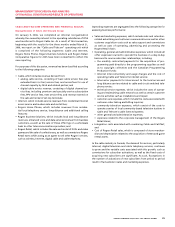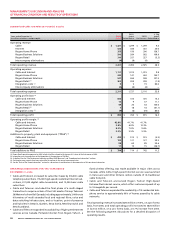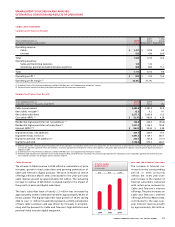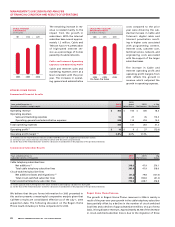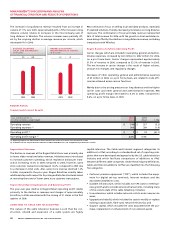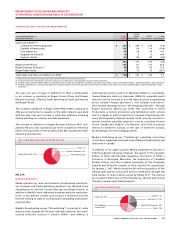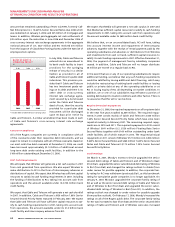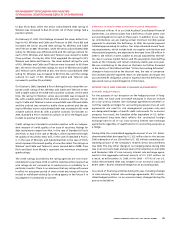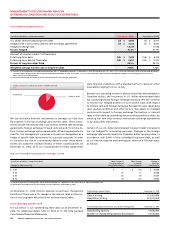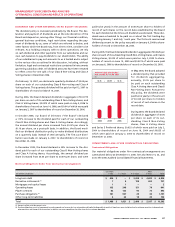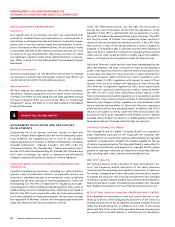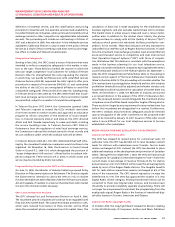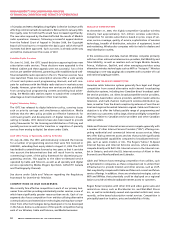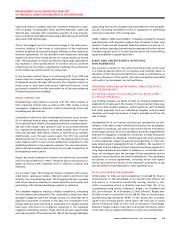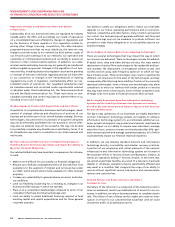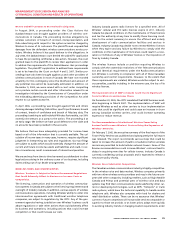Rogers 2006 Annual Report Download - page 49
Download and view the complete annual report
Please find page 49 of the 2006 Rogers annual report below. You can navigate through the pages in the report by either clicking on the pages listed below, or by using the keyword search tool below to find specific information within the annual report.
45
RO GER S CO MMU NIC AT ION S IN C . 20 0 6 ANN UA L RE POR T
MANAGEMENT’S DISCUSSION AND ANALYSIS
OF FINANCIAL CONDITION AND RESULTS OF OPERATIONS
to Ba2 (from Ba3), while the senior subordinated debt rating of
Wireless was increased to Ba3 (from B2). All of these ratings had a
positive outlook.
On February 27, 2007, Fitch Ratings increased the issuer default rat-
ings for RCI, Wireless and Cable and Telecom to BBB- (from BB) and
increased the senior secured debt ratings for Wireless and Cable
and Telecom to BBB- (from BB+), while the senior subordinated debt
rating for Wireless was affirmed at BB and the ratings outlook for
each of RCI, Wireless and Cable and Telecom was revised to stable
(from positive). On July 26, 2006, Fitch upgraded the ratings for RCI,
Wireless and Cable and Telecom. The issuer default ratings for each
of RCI, Wireless and Cable and Telecom were increased to BB (from
BB-), the senior secured debt ratings for each of Wireless and Cable
and Telecom were affirmed at BB+, the senior subordinated debt
rating for Wireless was increased to BB (from BB-) and the ratings
outlook for each of RCI, Wireless and Cable and Telecom was
increased to positive (from stable).
On October 4, 2006, Standard & Poor’s Ratings Services raised the cor-
porate credit rating of RCI, Wireless and Cable and Telecom to BB+
with a stable outlook (from BB with a positive outlook). At the same
time, the rating for Wireless’ senior secured debt was increased to
BB+ with a stable outlook (from BB with a positive outlook), the rat-
ing for Cable and Telecom’s senior secured debt was affirmed at BB+
and the outlook was revised to stable (from positive) and the rat-
ing for Wireless’ senior subordinated debt was increased to BB- with
a stable outlook (from B+ with a positive outlook). On October 27,
2005, Standard & Poor’s revised its outlook on all of the Rogers pub-
lic debt to positive from stable.
Credit ratings are intended to provide investors with an indepen-
dent measure of credit quality of an issue of securities. Ratings for
debt instruments range from AAA, in the case of Standard & Poor’s
and Fitch, or Aaa in the case of Moody’s, which represent the high-
est quality of securities rated, to D, in the case of Standard & Poor’s,
C, in the case of Moody’s and Substantial Risk in the case of Fitch,
which represent the lowest quality of securities rated. The ratings on
Wireless’ and Cable and Telecom’s senior secured debt of BBB- from
Fitch and Baa3 from Moody’s represent the minimum investment
grade ratings.
The credit ratings accorded by the rating agencies are not recom-
mendations to purchase, hold or sell the rated securities inasmuch as
such ratings do not comment as to market price or suitability for a
particular investor. There is no assurance that any rating will remain
in effect for any given period of time or that any rating will not be
revised or withdrawn entirely by a rating agency in the future if in
its judgment circumstances so warrant.
Defic iency of Pen sion Plan Assets Over Acc rued Obligation s
As disclosed in Note 19 to our 2006 Audited Consolidated Financial
Statements, our pension plans had a deficiency of plan assets over
accrued obligations for each of these years. In addition to our regu-
lar contributions, we are making certain minimum monthly special
payments to eliminate this deficiency. In 2006, the special payment
totalled approximately $5 million. Our total estimated annual fund-
ing requirements, which include both our regular contributions and
these special payments, are expected to decrease from $28 million in
2006 to $25 million in 2007, subject to annual adjustments thereaf-
ter, due to various market factors and the assumption that staffing
levels at the Company will remain relatively stable year-over-year.
We are contributing to the plans on this basis. As further discussed
in the section of this MD&A entitled “Critical Accounting Estimates”,
changes in factors such as the discount rate, the rate of compensa-
tion increase and the expected return on plan assets can impact the
accrued benefit obligation, pension expense and the deficiency of
plan assets over accrued obligations in the future.
INTEREST RATE AND FOREIGN EXCHANGE MANAGEMENT
Ec onomic Hedge Analysis
For the purposes of our discussion on the hedged portion of long-
term debt, we have used non-GAAP measures in that we include
all cross-currency interest rate exchange agreements (whether or
not they qualify as hedges for accounting purposes) since all such
agreements are used for risk management purposes only and
are designated hedges of specific debt instruments for economic
purposes. As a result, the Canadian dollar equivalent of U.S. dollar-
denominated long-term debt reflects the contracted foreign
exchange rate for all of our cross-currency interest rate exchange
agreements regardless of qualifications for accounting purposes as
a hedge.
During 2006, the consolidated aggregate amount of our U.S. dollar-
denominated debt decreased by U.S. $22 million due to the January
2006 redemption of our $26 million (U.S. $22 million) remaining out-
standing amount of the Company’s 10.625% Senior Secured Notes
due 2008. The only other change in our hedging status during 2006
was on an economic basis and was due to the maturities in June 2006
and December 2006 of cross-currency interest rate exchange agree-
ments in the aggregate notional amount of U.S. $327 million. As
a result, as at December 31, 2006, 91.4% (2005 – 97.7%) of our U.S.
dollar-denominated debt was hedged on an economic basis and
85.6% (2005 – 85.2%) remained hedged on an accounting basis.
As a result of financing activities during the year, including changes
in cross-currency interest rate exchange agreements, RCI’s consoli-
dated hedged position, on an economic basis, changed during the
year as noted below.


